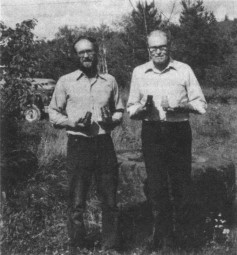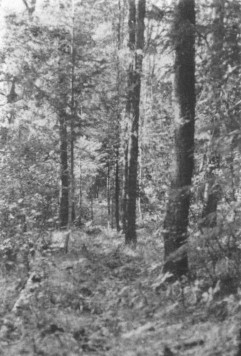Worthwhile Endeavor on the "Collins Line"
by J Chester Gordon
Reprinted from "INSULATORS - Crown Jewels of the Wire", May 1984, page 26
My wife Jo and I first heard about the Collins Overland Telegraph Line in 1970
while exploring in the Dawson City country in the Yukon. We are history buffs
and travel in northern Canada every summer.
The Collins Line was planned to
connect all the major capitals of the world. Western Union started in 1865 to
build a line through Canada, Alaska, under the Bering Sea, thence across Siberia
to Moscow and on to London.
Not until 1979 did we get into an area where the
Line had actually been built, in Hazelton, British Columbia. We knew that
Western Union's effort to reach Moscow had ended in this area, aborted when the
Atlantic cable was successfully laid in 1866. But not until 1982 did we meet
anyone who knew anything about the Line.
That summer we drove to Quesnel (Kwin-nell),
British Columbia. Here we met Dwight Dodge.
Dodge lives within one hundred yards
of the old Line. He has spent most of his life in this country, having come here
with his folks to operate a sawmill. His parents returned to Washington State,
but Dwight stayed on. Over the years he has explored many miles of the Collins
Line.
Dwight took us out, and, finally, I was standing on the Collins Overland
Line. He showed me a piece of wire buried in a slide above the old road that
followed the Line. He showed me how the old wire, the rolled wire, differed from
the modern day drawn wire. It tends to fray when you twist it to break it. He
also showed me some of the insulators in his collection, permitting me to hold a
Chester and a Tillotson that he had found on the Line.

Dwight Dodge (left) and J Chester Gordon holding threadless Chester and
Tillotson insulators. Dodge found these insulators on the old Collins Telegraph
Line. |
He told of his desire, of
his dream, to see a hiking path developed along the Line from Quesnel to
Hazelton, a 350 mile stretch. He told us that he and some of his friends had
been meeting over Labor Day weekends to hew and hack brush from a few more miles
each year. By 1982 they had cleared fifteen miles.
Jo and I returned to Quesnel
in 1983. We had more time on this trip. One afternoon we went with Dwight to
brush out more of the Line. It was a beautiful, sunny August afternoon, cool in
the shade under the trees.
Dwight drove us twenty-two miles in his Dodge pickup
to the end of his cleared trail. He kept watching the right hand side of the
road until he spotted two fading ruts that were overgrown with brush and six to
eight foot tall lodge pole pine. He smashed his way into the woods for 400 or so
yards to where I could see his brushed out trail headed north toward "Roosha".
I was ready for the experience that I had anticipated for a long time.

Looking north toward "Roosha" along a brushed out section of old
Collins Line. There are places where the old trail, beaten down by untold
numbers of hooves and feet, can still be traced. |
Dwight
brought along two machetes and his metal detector, Jo brought her camera, and I
brought my bottle fork. I hacked away and packed the metal detector so that I
could make an occasional foray into the brush, hoping to find something that
Dwight had missed. I did not find even a piece of wire, except those pieces that
Dwight had found, rolled up, and hung in trees beside the trail.
The terrain in
this area is relatively level. It has a minimum of underbrush beneath and the
pines and scattered spruce. You can still find evidence of the cuts made made
where the old road slanted down the hillsides into washes and ravines. This road
was carved out by the Collins people in 1866. They used trains of pack animals
to haul their supplies along as the line construction progressed. This road or
trail thereafter became a thoroughfare for Indians, moose and white men.
Dwight
would like to see his trail brushing project move ahead at a faster pace. He
would like to find people in the few and scattered communities in that area who
would volunteer to help. There are many miles of the Line that are now under
cultivation. But there still are miles of Line in open country. The rebuilt
Telegraph Road is still traveled between Quesnel and Fraser Lake. It is gravel.
Most of the Line has been harvested. Much of the land has been fenced. The wire
was the first to go. Indians used it for suspension bridges, hunters and
trappers would snip off stretches according to their needs, and then the farmers
came. Hay wire was a priceless item to these early pioneers.
There are still
Chesters and Tillotsons along the Line buried beneath leaves and dirt or in
swamps. Most insulators were picked up years ago, or served for target practice.
Dwight and his friends keep pressing on with his project. I know that he would
welcome assistance from anyone who would be prepared to get out in the woods for
half a day or so. Jo and I hope to return again, if not this summer, then in
1985.
| 